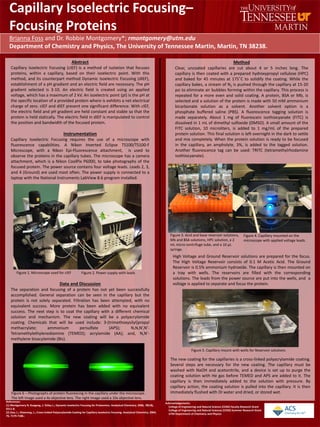
cIEF poster
- 1. Capillary Isoelectric Focusing– Focusing Proteins Brianna Foss and Dr. Robbie Montgomery*; rmontgomery@utm.edu Department of Chemistry and Physics, The University of Tennessee Martin, Martin, TN 38238. Abstract Capillary Isoelectric Focusing (cIEF) is a method of isolation that focuses proteins, within a capillary, based on their isoelectric point. With this method, and its counterpart method Dynamic Isoelectric Focusing (dIEF), establishment of a pH gradient and an electric field are necessary. The pH gradient selected is 3-10. An electric field is created using an applied voltage, which has a maximum of 2 kV. An isoelectric point (pI) is the pH at the specific location of a provided protein where is exhibits a net electrical charge of zero. cIEF and dIEF present one significant difference. With cIEF, the electric field and pH gradient are held constant and stable so that the protein is held statically. The electric field in dIEF is manipulated to control the position and bandwidth of the focused protein. Instrumentation Capillary Isoelectric Focusing requires the use of a microscope with fluorescence capabilities. A Nikon Inverted Eclipse TS100/TS100-F Microscope, with a Nikon Epi-Fluorescence attachment, is used to observe the proteins in the capillary tubes. The microscope has a camera attachment, which is a Nikon CoolPix P6000, to take photographs of the focused protein. The power source contains four voltage leads. Leads 2, 3, and 4 (Ground) are used most often. The power supply is connected to a laptop with the National Instruments LabView 8.6 program installed. Data and Discussion The separation and focusing of a protein has not yet been successfully accomplished. General separation can be seen in the capillary but the protein is not solely separated. Filtration has been attempted, with no equivalent success. More protein has been added with no equivalent success. The next step is to coat the capillary with a different chemical solution and mechanism. The new coating will be a polyacrylamide coating. Chemicals that will be used include: 3-(trimethoxysilyl)propyl methacrylate; ammonium persulfate (APS); N,N,N’,N’- Tetramethylethylenediamine (TEMED); acrylamide (AA); and, N,N’- methylene bisacylamide (Bis). References: (1) Montgomery R; Xuegang, J; Tolley L.; Dynamic Isoelectric Focusing for Proteomics. Analytical Chemistry. 2006, 78(18), 6511-8. (2) Gao, L.; Shaorong, L.; Cross-Linked Polyacrylamide Coating for Capillary Isoelectric Focusing. Analytical Chemistry. 2004, 76, 7179-7186.: Figure 6 – Photographs of protein fluorescing in the capillary under the microscope. The left image used a 4x objective lens. The right image used a 10x objective lens. Acknowledgements: College of Engineering and Natural Science (CENS) Faculty Research Grant College of Engineering and Natural Sciences (CENS) Summer Research Grant UTM Department of Chemistry and Physics Figure 1. Microscope used for cIEF Figure 2. Power supply with leads Figure 3. Acid and base reservoir solutions, Mb and BSA solutions, HPC solution, a 2 mL micro-centrifuge tube, and a 10 µL syringe. High Voltage and Ground Reservoir solutions are prepared for the focus. The High Voltage Reservoir consists of 0.1 M Acetic Acid. The Ground Reservoir is 0.5% ammonium hydroxide. The capillary is then mounted on a tray with wells. The reservoirs are filled with the corresponding solutions. The leads from the power source are put into the wells, and a voltage is applied to separate and focus the protein. Figure 5. Capillary mount with wells for Reservoir solutions Figure 4. Capillary mounted on the microscope with applied voltage leads. Method Clear, uncoated capillaries are cut about 4 or 5 inches long. The capillary is then coated with a prepared hydroxypropyl cellulose (HPC) and baked for 45 minutes at 175 ͦC to solidify the coating. While the capillary bakes, a stream of N2 is pushed through the capillary at 15-20 psi to eliminate air bubbles forming within the capillary. This process is repeated for a more even and solid coating. A protein, BSA or Mb, is selected and a solution of the protein is made with 50 mM ammonium bicarbonate solution as a solvent. Another solvent option is a phosphate buffered saline (PBS). A fluorescence tagging solution is made separately. About 1 mg of fluorescein isothiocyanate (FITC) is dissolved in 1 mL of dimethyl sulfoxide (DMSO). A small amount of the FITC solution, 10 microliters, is added to 1 mg/mL of the prepared protein solution. This final solution is left overnight in the dark to settle and mix completely. When the protein solution is ready to be focused in the capillary, an ampholyte, 3%, is added to the tagged solution. Another fluorescence tag can be used: TRITC (tetramethylrhodamine isothiocyanate). The new coating for the capillaries is a cross-linked polyacrylamide coating. Several steps are necessary for the new coating. The capillary must be washed with NaOH and acetonitrile, and a device is set up to purge the coating solution with He gas before TEMED and APS are added to it. The capillary is then immediately added to the solution with pressure. By capillary action, the coating solution is pulled into the capillary. It is then immediately flushed with DI water and dried, or stored wet.